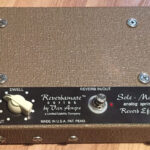George Harrison’s “Something” stands as a testament to his songwriting genius within The Beatles, often hailed as one of the most beautiful ballads ever created. Featured on the iconic “Abbey Road” album, this song is celebrated for its sophisticated chord progression, memorable vocal melody, and a guitar solo that’s nothing short of iconic. Notably, “Something” has become the second most covered Beatles song, with over 150 artists interpreting it in their own style, a true mark of its enduring appeal. Rumored to be inspired by Harrison’s former wife, Patti Boyd, “Something” is a masterclass in songwriting and guitar arrangement.
In this comprehensive guide, we will delve into the intricacies of “Something,” providing you with detailed guitar tabs for the chords, an in-depth breakdown of George Harrison’s legendary guitar solo, and a music theory analysis that uncovers the song’s harmonic brilliance. Whether you are a beginner guitarist looking to expand your chord vocabulary or an experienced player aiming to master Harrison’s solo, this lesson provides everything you need to learn “Something” on guitar.
“Something” Guitar Chords: A Detailed Guide
Usually, guitar lessons start with chord diagrams, but “Something” calls for a slightly different approach due to its harmonic richness. Let’s first examine the complete chord chart for “Something” to grasp the overall structure before we dissect each section step-by-step.
 Full chord chart for "Something" by The Beatles
Full chord chart for "Something" by The Beatles
Now that you have a broad view of the chord progression, let’s break down the chord diagrams for each section, starting with the intro. The voicings suggested below are designed for playability, minimizing hand movement between chords, making it easier to learn the intro smoothly.
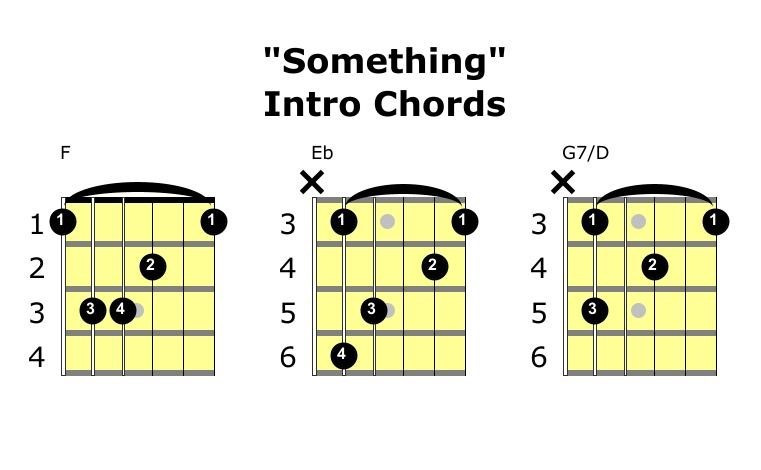 Intro chords diagrams for "Something" guitar tab
Intro chords diagrams for "Something" guitar tab
Moving on to the verse chords, open position voicings are particularly effective in this section. They not only capture the song’s warm, acoustic feel but also present the most straightforward way to fret each chord, perfect for players of all levels.
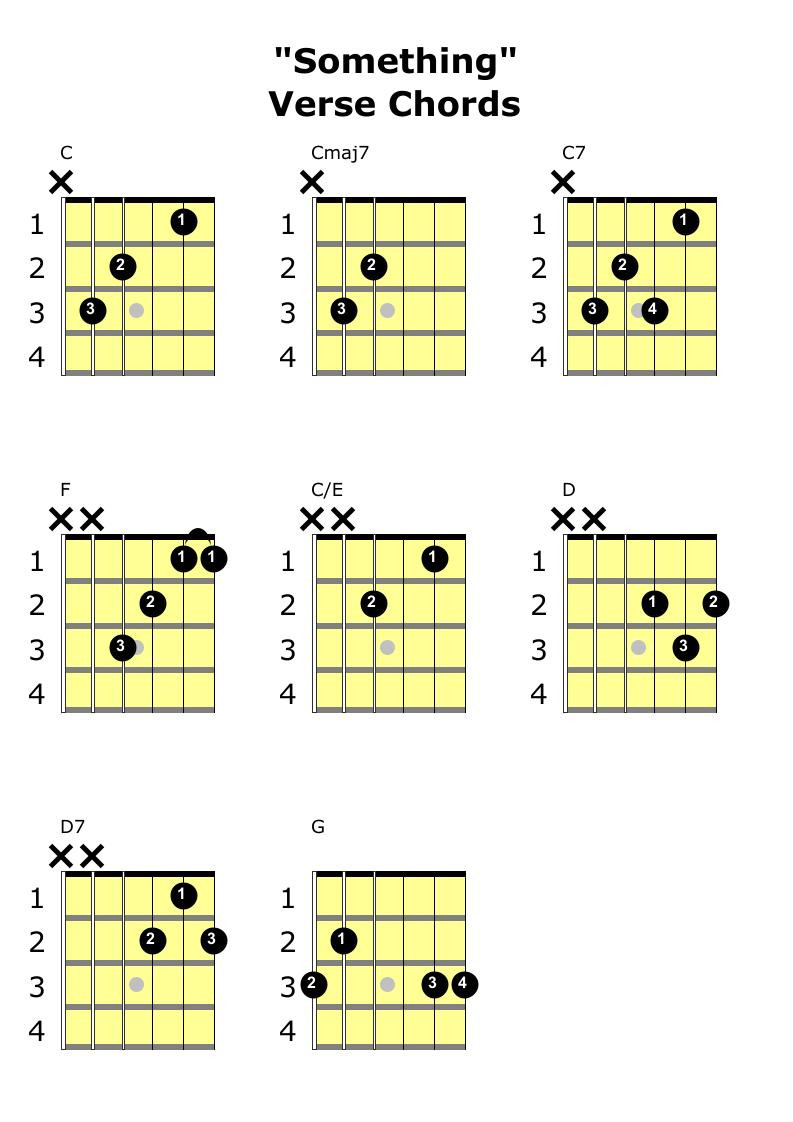 Verse chords diagrams for "Something" guitar tab
Verse chords diagrams for "Something" guitar tab
In bar 8, we encounter the A minor section, where you have options for voicing the Am chord. Initially, we present the open position chords as used in the verse, followed by a move up to the 5th fret for the D9 chord, providing a seamless transition.
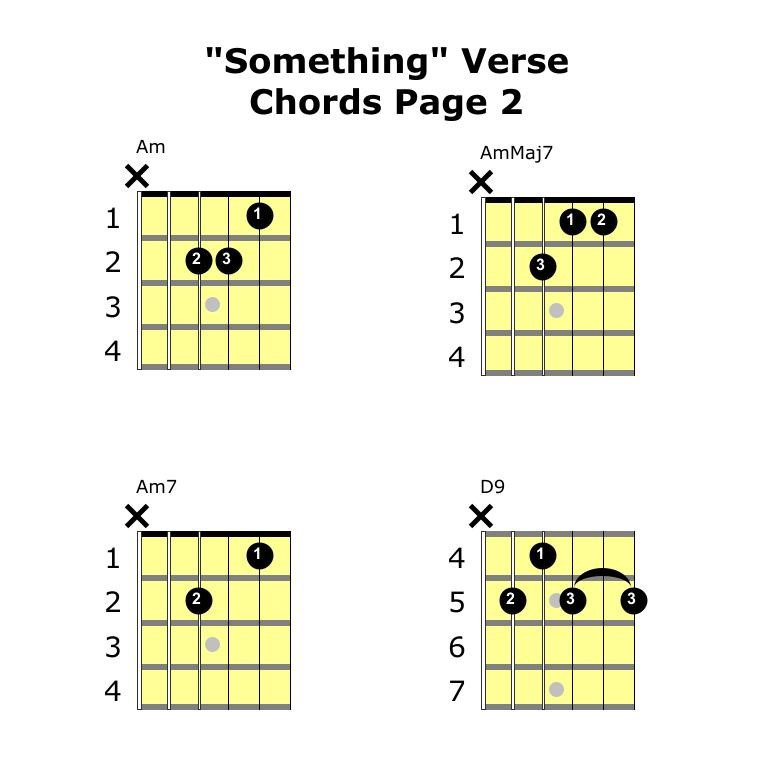 A minor section chords in open position for "Something" guitar tab
A minor section chords in open position for "Something" guitar tab
Alternatively, consider these alternate voicings for the same chords. If you are comfortable using your thumb to fret bass notes, these voicings in the 5th fret might be preferable for a more fluid shift into the D9 chord and a different tonal color.
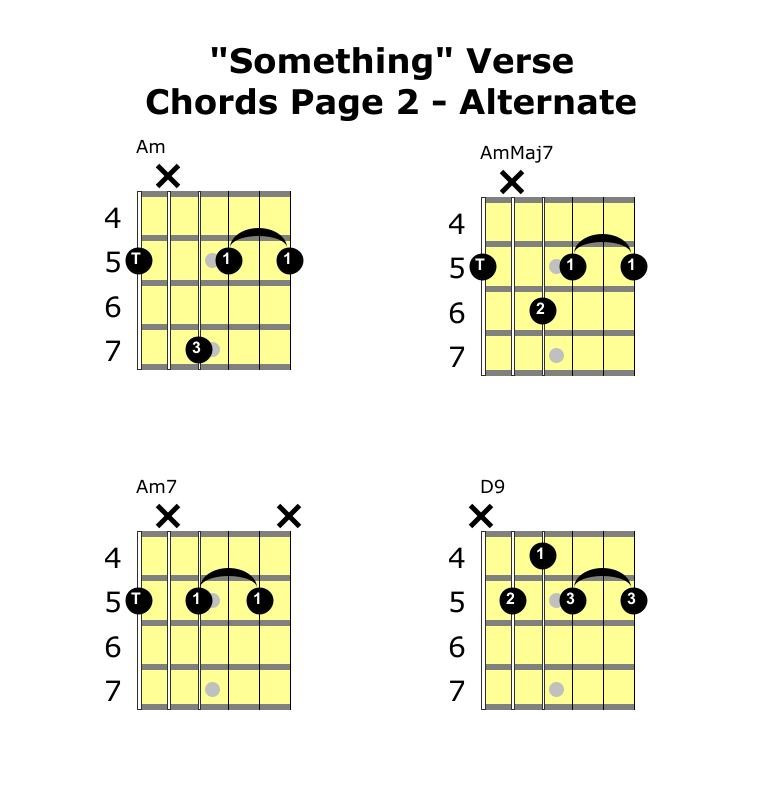 Alternate voicings for A minor section chords in "Something" guitar tab
Alternate voicings for A minor section chords in "Something" guitar tab
Finally, let’s explore the chord diagrams for the chorus. The first four chords are beautifully voiced on the highest four strings, creating a shimmering quality that complements the melodic lift of the chorus. These voicings are included in the diagrams below.
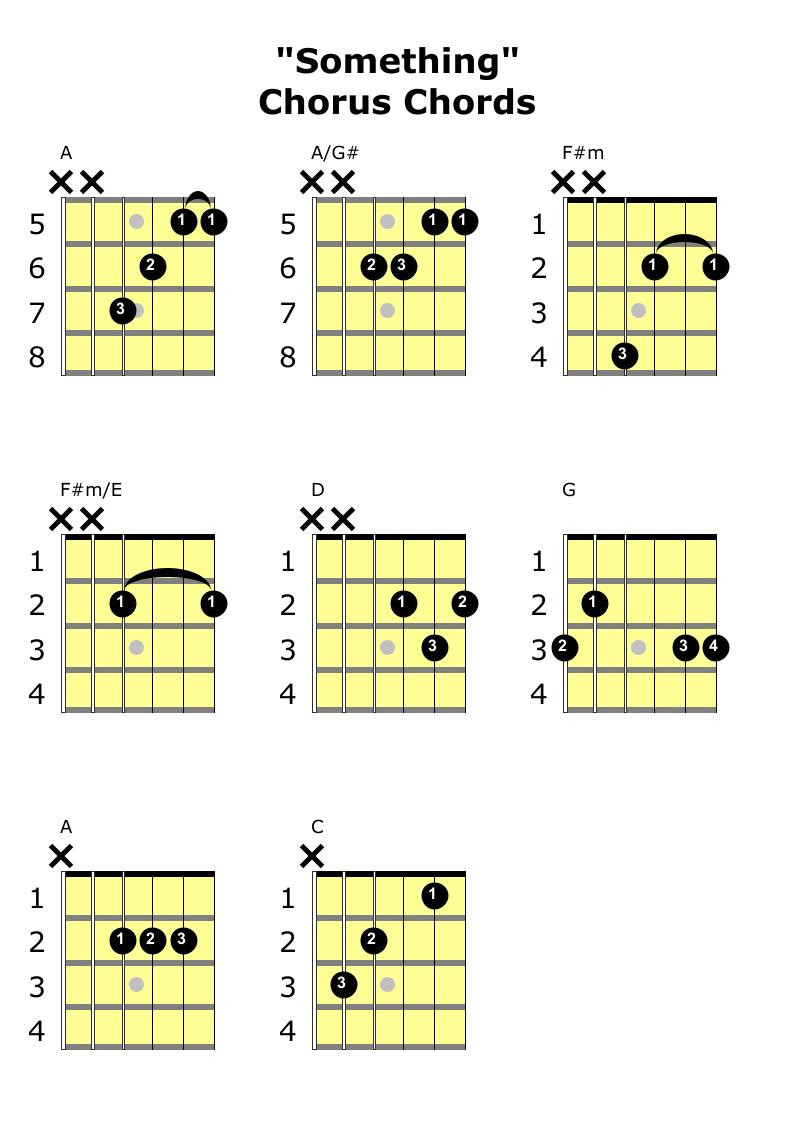 Chorus chords diagrams for "Something" guitar tab
Chorus chords diagrams for "Something" guitar tab
For an added layer of authenticity, you can choose to emulate Paul McCartney’s bassline on the guitar instead of playing the A and C chords at the end of the chorus progression. Here’s the bassline transposed for guitar over the A chord in bar 15 and the C chord in bar 19, adding a melodic bass element to your rendition.
 Bassline transposition over A and C chords in "Something" chorus guitar tab
Bassline transposition over A and C chords in "Something" chorus guitar tab
“Something” Chord Progression: A Music Theory Deep Dive
Harmonic Outline
“Something” showcases a remarkably sophisticated chord progression, incorporating advanced music theory concepts that can enrich your own songwriting palette. While primarily in the key of C Major, the song masterfully employs borrowed chords and a captivating modulation in the chorus. To provide a foundational understanding, here’s the C Major scale harmonized in triads and four-note chords as a reference point.
C Major Scale Harmonized in Triads:
| Degree | I | II | III | IV | V | VI | VII | VIII |
|---|---|---|---|---|---|---|---|---|
| Chord | C | Dm | Em | F | G | Am | Bdim | C |
| Quality | Major | Minor | Minor | Major | Major | Minor | Dim. | Major |
C Major Scale Harmonized in 4-Note Chords:
| Degree | I | II | III | IV | V | VI | VII | VIII |
|---|---|---|---|---|---|---|---|---|
| Chord | CMaj7 | Dm7 | Em7 | FMaj7 | G7 | Am7 | Bm7b5 | CMaj7 |
| Quality | Maj7 | Min7 | Min7 | Maj7 | Dom7 | Min7 | m7b5 | Maj7 |
Intro Harmony
The intro begins with an F chord, the IV chord in C Major, establishing a familiar tonal center. Immediately, this is followed by an Eb chord, a beautiful example of a borrowed chord from the parallel minor key of C Minor. This chromatic movement adds depth and a touch of melancholy right from the start. Finally, the G7 chord, voiced with its 5th (D) in the bass (G7/D), acts as a dominant, creating a perfect cadence resolving to the C chord at the verse’s onset. This G7/D chord is the V chord in C, powerfully setting up the key. Adding to the intro’s allure is a descending bassline that moves through F, Eb, and D, naturally leading to C, which significantly influences the chord choices and their smooth transitions.
Verse Chordal Motion
The verse opens on the tonic chord, C, explored through three variations: C, Cmaj7, and C7. This sequence is a prime example of “chromatic embellishment of static harmony.” In simpler terms, the fundamental C chord remains constant, while a single note within the chord shifts each bar to create different chord qualities. The basic C major triad (C, E, & G) is maintained throughout. In the first C Major chord, the octave C note descends a semitone to B, resulting in Cmaj7 (C, E, G, & B). Then, B further descends a semitone to Bb, forming the C7 chord (C, E, G, & Bb). This technique of chromatic movement over a static root is a hallmark of sophisticated songwriting, also found in songs like Stevie Wonder’s “I Just Called To Say I Love You” and Sixpence None The Richer’s “Kiss Me.”
As noted in the chart, C7 is not diatonic to C Major, making it another borrowed chord. It functions as the dominant 7th of F in bar 4, creating another perfect cadence, this time resolving to the F chord. F is the IV chord in C Major and progresses back to chord I with C/E. Here, the 3rd of C, E, is placed in the bass, creating a smooth descending bassline from F to E and then to D in bar 5.
Bar 5 features both D and D7 chords, neither of which belongs to the key of C Major. These chords effectively create another V-I cadence, this time in the key of G Major, resolving to the G chord in bar 6. D is the V chord of G, making this a temporary shift in tonal focus. Next, in bar 8, we move to the relative minor of C, A minor, which introduces another instance of chromatic embellishment. This time, it involves three A minor chords in bars 8 and 9. The A Minor triad comprises A, C, and E. The root A in the octave descends a semitone to G# to form AmMaj7 (A, C, E, G#), borrowed from the A harmonic minor scale. G# then descends another semitone to G, creating Am7 (A, C, E, G). This Am – AmMaj7 – Am7 progression is quite common and appears in jazz standards like “My Funny Valentine,” Led Zeppelin’s “Stairway To Heaven,” and the James Bond Theme. The G in the Am7 chord then descends another semitone to F#, while the root changes to D, resulting in the D9 chord in bar 9 (D, F#, A, C, E).
Chorus Key Change
The chorus of “Something” features a brilliant modulation to the key of A Major. This key change provides a lift and contrast, enhancing the emotional impact of the chorus. Here’s the A Major scale harmonized in triads for reference.
A Major Scale Harmonized in Triads:
| Degree | I | II | III | IV | V | VI | VII# | VIII |
|---|---|---|---|---|---|---|---|---|
| Chord | A | Bm | C#m | D | E | F#m | G#dim | A |
| Quality | Major | Minor | Minor | Major | Major | Minor | Dim. | Major |
A Major is the relative major of C# minor, and while C# minor isn’t directly related to C Major (which is relative to A minor), the move to A Major from C provides a pleasing and uplifting shift. The chorus begins on chord I of A Major (A), before moving to the same chord with a G# in the bass, creating an Amaj7 sound (A, C#, E, & G#). This bass note creates a descending bassline from A to G#, then to the F#m chord, which is chord VI in A Major, before reaching F#m/E. A temporary key change then occurs a whole tone lower to G Major, with chords I (G) and V (D) respectively, before modulating back to A Major. On the second chorus, the song cleverly resolves back to the original key of C Major instead of returning to A, creating a satisfying harmonic loop back to the verse.
Guitar Intro Tab for “Something”
George Harrison’s guitar work on “Something” is nothing short of exquisite. In this section, we provide the guitar tab for the iconic intro lick and a complete tab for his unforgettable guitar solo after the chorus. We’ll also analyze Harrison’s note choices in relation to the underlying chords to understand his melodic genius. Let’s start with the intro lick guitar tab:
e|---------------------------------------------------------|
B|---------------------------------------------------------|
G|---------------------------------------------------------|
D|-------3-3-3-------3-3-3-------2-2-2-------0-0-0-------|
A|-1-1-1-----1-1-1-1-----0-0-0-0-----0-0-0---------------|
E|-----------------------------------------3-3-3-----3-3-3-|Part of the intro’s brilliance lies in Harrison’s use of chord tones. He begins by playing the 3rd of F (A) before bending up to the 5th (C). Over the Eb chord, he emphasizes the 5th (Bb), then ascends a semitone to B, which is the 3rd of Eb, resolving the chromatic movement with the root note of C. This masterful melodic contouring makes the intro instantly recognizable and harmonically rich.
“Something” Guitar Solo Tab
Below is a transcription of George Harrison’s perfect guitar solo on “Something”. This solo is celebrated for its melodic phrasing, emotional depth, and seamless integration with the song’s harmonic structure.
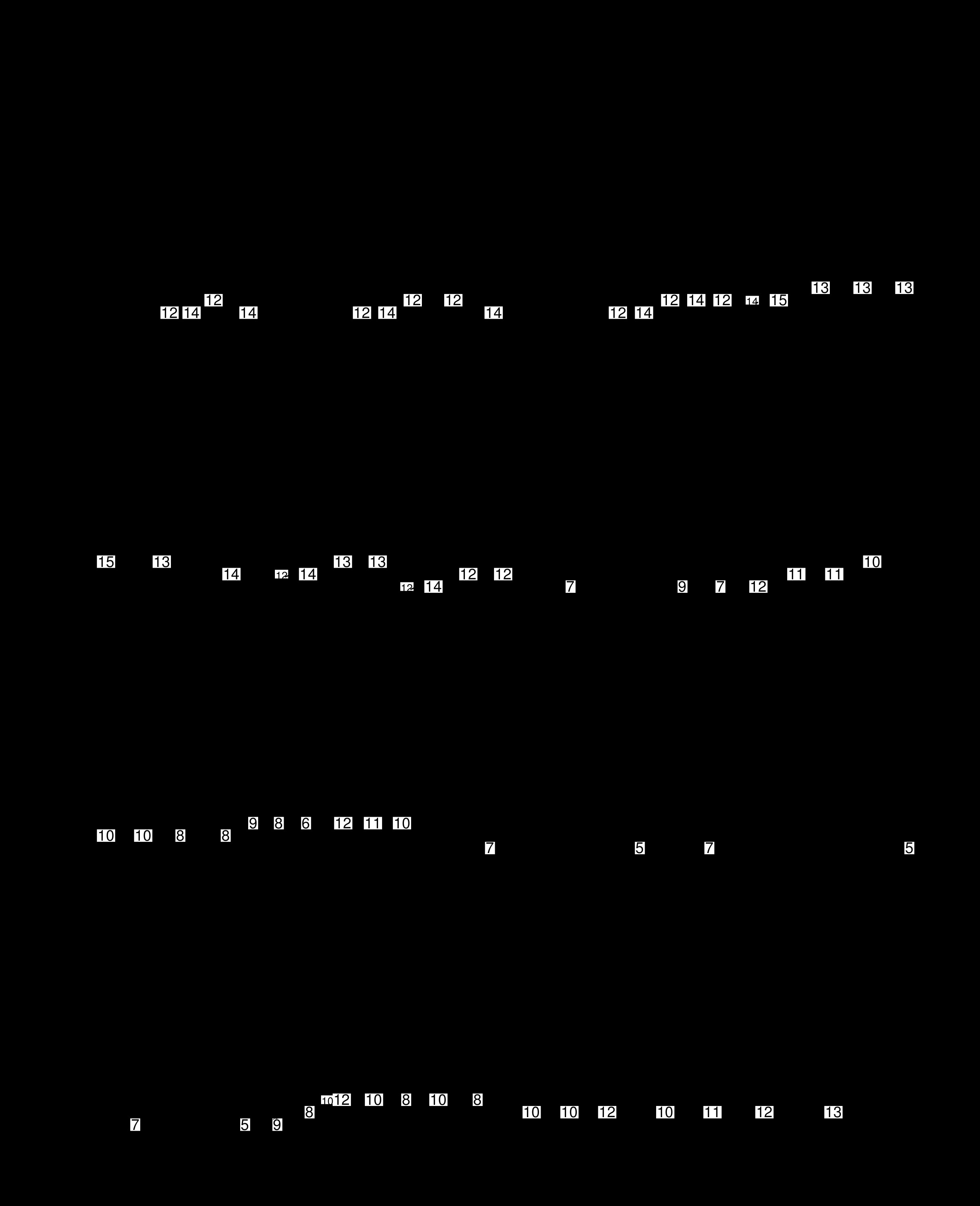 Guitar solo tab for "Something" by George Harrison
Guitar solo tab for "Something" by George Harrison
Guitar Solo: Music Theory Analysis
As mentioned, Harrison’s genius in this solo stems from his consistent use of chord tones, landing on harmonically significant notes at crucial moments. To understand this further, the table below outlines the notes within each chord of the verse progression over which Harrison solos.
Verse Chord Tones for Solo Analysis:
| Chord | Chord Tones (Root, 3rd, 5th, etc.) |
|---|---|
| C | C E G (Root, 3rd, 5th) |
| CMaj7 | C E G B (Root, 3rd, 5th, 7th) |
| C7 | C E G Bb (Root, 3rd, 5th, b7th) |
| F | F A C (Root, 3rd, 5th) |
| C/E | E G C (3rd, 5th, Root) |
| D | D F# A (Root, 3rd, 5th) |
| D7 | D F# A C (Root, 3rd, 5th, b7th) |
| G | G B D (Root, 3rd, 5th) |
| Am | A C E (Root, b3rd, 5th) |
| AmMaj7 | A C E G# (Root, b3rd, 5th, Maj7) |
| Am7 | A C E G (Root, b3rd, 5th, b7th) |
| D9 | D F# A C E (Root, 3rd, 5th, b7th, 9th) |
The following tab of Harrison’s solo is annotated to show each interval he plays in relation to the underlying chord, providing a clear view of his note choices and target tones.
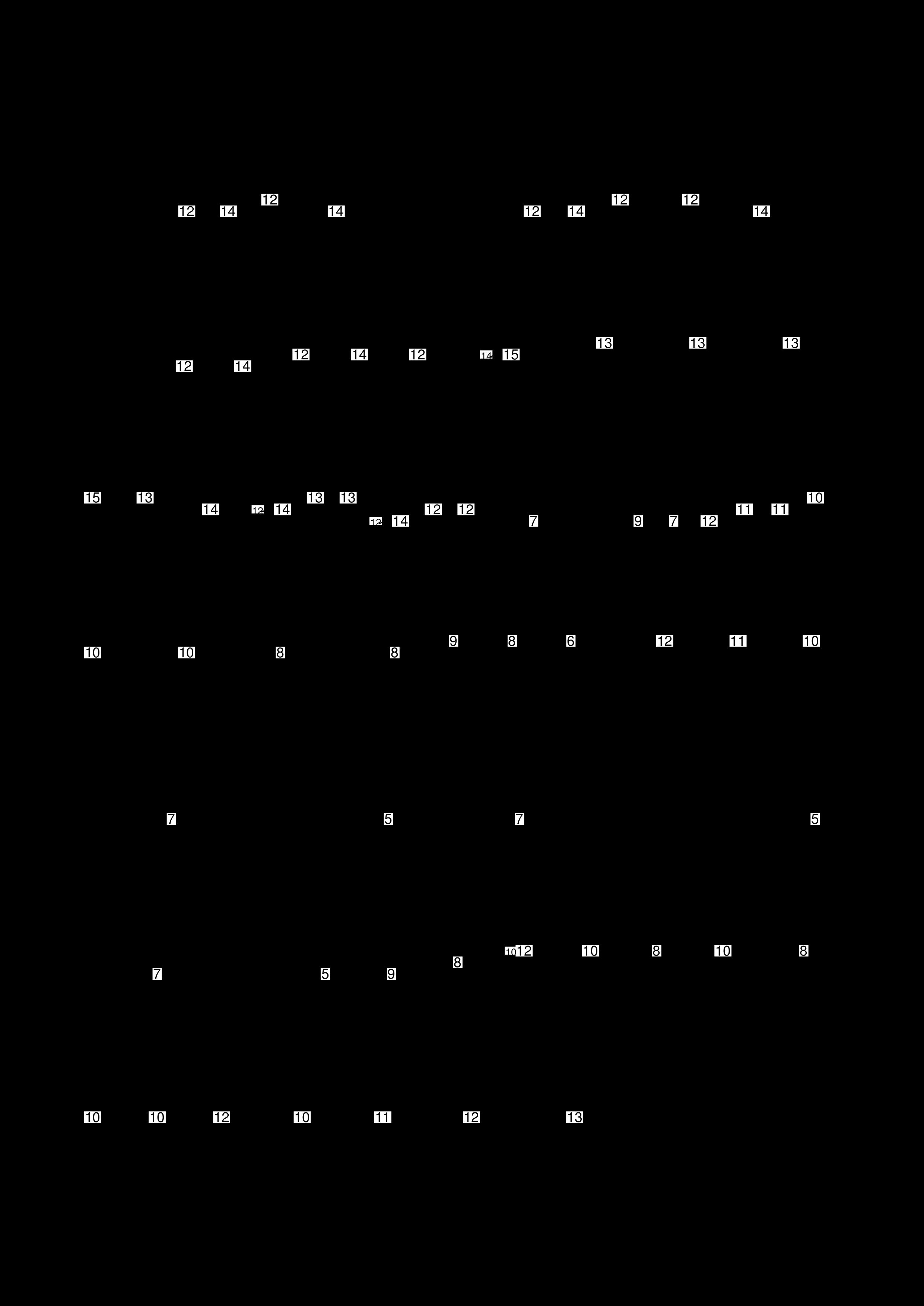 Annotated guitar solo tab for "Something" with theory analysis
Annotated guitar solo tab for "Something" with theory analysis
As the annotated tab reveals, Harrison frequently targets chord tones throughout his solo, especially the 3rds and 5ths. These are harmonically strong notes that create a sense of resolution and melodic coherence. While landing on root notes can sometimes sound predictable, Harrison’s emphasis on 3rds and 5ths adds sophistication.
Of particular interest are the “outside” notes Harrison employs over the G chord in bar 6. This phrase is unusual, incorporating altered notes like b5s and b13s, reminiscent of jazz guitar phrasing, possibly influenced by Django Reinhardt, whom Harrison cited as an early inspiration. This lick creates tension before the bending phrase in bar 7, masterfully executed and surprisingly melodic despite its unconventional note choices.
Final Thoughts on “Something” Guitar Tab and Lesson
We hope you’ve enjoyed this in-depth Beatles guitar lesson and music theory exploration of “Something”. This song is a rewarding study for any musician, offering insights into sophisticated chord progressions and a beautifully melodic guitar solo. We encourage you to apply the music theory concepts discussed to your own songwriting and improvisation. The Beatles’ musical legacy is vast and continues to inspire, and we plan to analyze more of their iconic songs in future lessons.
Keep practicing and exploring the rich musical landscape of The Beatles!
PB.
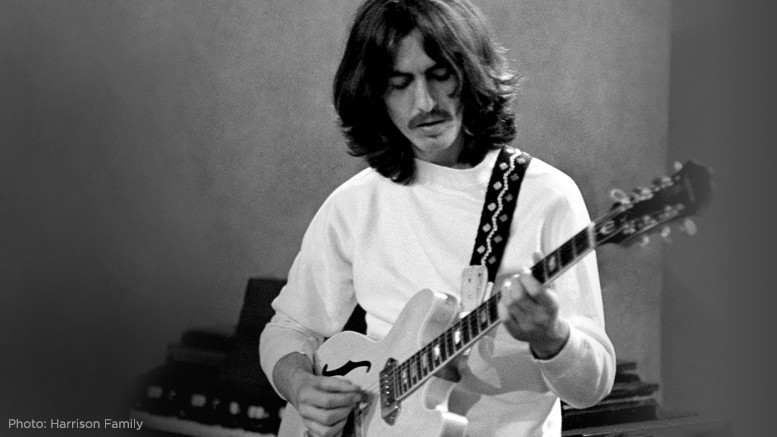 George Harrison playing guitar
George Harrison playing guitar

